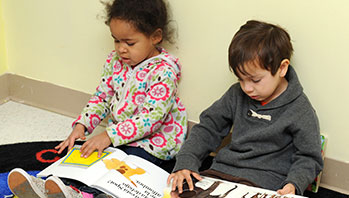- families book-browsing box
- friends book-browsing box
- family
- feel
- friend
MA Standards:
Foundational Skills/RF.PK.MA.1.a: Handle books respectfully and appropriately, holding them right-side-up and turning pages one at a time from front to back.
Foundational Skills/RL.PK.MA.7: With prompting and support, make predictions about what happens next in a picture book after examining and discussing the illustrations.
Head Start Outcomes:
Literacy Knowledge/Book Appreciation and Knowledge: Recognizes how books are read, such as front-to-back and one page at a time, and recognizes basic characteristics, such as title, author, and illustrator.
PreK Learning Guidelines:
Health Education 16: Recognize and describe or represent emotions such as happiness, surprise, anger, fear, sadness.
English Language Arts/Language 2: Participate actively in discussions, listen to the ideas of others, and ask and answer relevant questions.
English Language Arts/Reading and Literature 6: Listen to a wide variety of age appropriate literature, read aloud.
Independent and Partner Reading, Unit 1, Week 1

© Commonwealth of Massachusetts, Department of Early Education and Care (Jennifer Waddell photographer). All rights reserved.
Educator Prep: Stock the Library Center with a variety of fiction and nonfiction books about different kinds of families and friends.
Encourage individuals or pairs to select a book about families or friends that interests them and to look at the words and pictures alone or together.
Children may need assistance in holding, reading, etc. Be sure to be available to:
- Demonstrate how to hold, handle, and care for a book.
- Show children where to begin reading and how to turn the pages.
- Do a picture walk with children and encourage them to look at the illustrations and talk about what the pictures tell about the story.
- Read parts of the book aloud and encourage active listening by asking questions that will help children make connections to the story. For example, for Knuffle Bunny Too, say,
- Trixie realizes that she has the wrong bunny. What does she do when she realizes it? How do you think Trixie feels that her bunny is missing?
- Do you have an animal or a blanket that you like to sleep with? How do you think you would feel if you discovered that it was missing?
